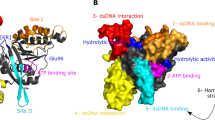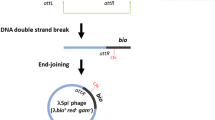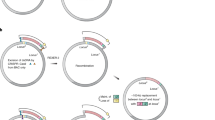Abstract
The small circular genomes of several bacteriophages and a number of plasmids have been used extensively to study various aspects of the mechanism of genetic recombination. Several studies have demonstrated that the interconversion between the circular monomers and larger circular oligomers of many plasmid DNAs is mediated, at least in part, by the pathway which carries out genetic recombination in wild-type Escherichia coli1–4. The recA, recB and recC mutations block conjugation-mediated recombination in E. coli5,6. However, Clark and his co-workers7,8 isolated two mutations, sbcA and sbcB, which indirectly suppress the recombination deficiency of recB and recC mutations. These indirect suppressor mutations seem to cause recombination by other pathways which require the recA gene product as well as products of other genes such as recF, recJ and recM, which are not normally required for recombination in E. coli9,10. Here we report an investigation of the effect of recombination-deficient mutations on plasmid recombination in E. coli. We show that sbcA mutations induce a new plasmid recombination pathway that is 10–15 times more efficient than the normal wild-type recombination pathway and independent of the recA and recF functions.
This is a preview of subscription content, access via your institution
Access options
Subscribe to this journal
Receive 51 print issues and online access
$199.00 per year
only $3.90 per issue
Buy this article
- Purchase on SpringerLink
- Instant access to full article PDF
Prices may be subject to local taxes which are calculated during checkout
Similar content being viewed by others
References
Hobom, G. & Hogness, D. S. J. molec. Biol. 88, 65–87 (1974).
Bedbrook, J. & Ausubel, F. Cell 9, 707–716 (1976).
Potter, H. & Dressler, D. Proc. natn. Acad. Sci. U.S.A. 74, 4168–4172 (1977).
Kolodner, R., Joseph, J., James, A., Dean, F. & Doherty, M. J. ICN–UCLA Symp. molec. cell. Biol. 19, 933–939 (1980).
Clark, A. J. & Margulies, A. D. Proc. natn. Acad. Sci. U.S.A. 53, 451–459 (1965).
Emmerson, P. T. & Howard-Flanders, P. J. Bact. 93, 1729–1731 (1967).
Barbour, S. D., Nagaishi, H., Templin, A. & Clark, A. J. Proc. natn. Acad. Sci. U.S.A. 67, 128–135 (1970).
Kushner, S. R., Nagaishi, H. & Clark, A. J. Proc. natn. Acad. Sci. U.S.A. 68, 824–827 (1971).
Horii, Z.-I. & Clark, A. J. J. molec. Biol. 80, 327–344 (1973).
Clark, A. J. ICN–UCLA Symp. molec. cell. Biol. 19, 891–899 (1980).
Hershfield, V., Boyer, H. W., Chow, L. & Helinski, D. R. J. Bact. 126, 447–453 (1976).
James, A. A., Morrison, P. M. & Kolodner, R. Proc. natn. Acad. Sci. U.S.A. (submitted).
Gordon, C. N., Rush, M. G. & Warner, R. C. J. molec. Biol. 47, 495–503 (1970).
Thompson, B. J. et al. J. molec. Biol. 91, 409–419 (1975).
Thompson, B. J., Camien, M. N. & Warner, R. C. Proc. natn. Acad. Sci. U.S.A. 73, 2299–2303 (1976).
Potter, H. & Dressler, D. Proc. natn. Acad. Sci. U.S.A. 73, 3000–3004 (1976).
Potter, H. & Dressler, D. Cold Spring Harb. Symp. quant. Biol. 43, 969–989 (1978).
Holliday, R. Genet. Res. 5, 282–304 (1964).
Meselson, M. & Radding, C. M. Proc. natn. Acad. Sci. U.S.A. 72, 358–361 (1975).
Broker, T. R. J. molec. Biol. 81, 1–16 (1973).
Tsujimoto, Y. & Ogawa, A. J. molec. Biol. 106, 423–436 (1976).
Bell, L. & Byers, B. Proc. natn. Acad. Sci. U.S.A. 76, 3445–3449 (1979).
Wolgemuth, D. J. & Hsu, M.-T. Nature 287, 168–171 (1980).
Warner, R. C., Fishel, R. A. & Wheeler, F. C. Cold Spring Harb. Symp. quant. Biol. 43, 957–968 (1978).
Hardies, S. C. et al. J. biol. Chem. 254, 5527–5534 (1979).
Bolivar, F., Rodrigues, R. L., Betlach, M. C. & Boyer, H. W. Gene 2, 75–93 (1977).
Luria, S. E. & Delbruck, M. Genetics 28, 491–504 (1943).
Wake, C. T. & Wilson, J. H. Cell 21, 141–148 (1980).
James, A. A., Morrison, P. M. & Kolodner, R. J. molec. Biol. (submitted).
Gillen, J. R. & Clark, A. J. in Mechanisms of Genetic Recombination (ed. Grell, R. F.) 123–136 (Plenum, New York, 1974).
Gillen, J. R., Willis, D. K. & Clark, A. J. J. Bact. 145, 521–532 (1981).
Vapnek, D., Alton, N. K., Bassett, C. L. & Kushner, S. R. Proc. natn. Acad. Sci. U.S.A. 73, 3492–3496 (1976).
Porter, R. D., McLaughlin, T. & Low, B. Cold Spring Harb. Symp. quant. Biol. 43, 1043–1047.
Stahl, F. W. A. Rev. Genet. 13, 7–24 (1979).
Barbour, S. D. & Clark, A. J. Proc. natn. Acad. Sci. U.S.A. 65, 955–961 (1970).
Goldmark, P. J. & Linn, S. Proc. natn. Acad. Sci. U.S.A. 67, 434–438 (1972).
Kolodner, R. Proc. natn. Acad. Sci. U.S.A. 77, 4847–4851 (1980).
Thuring, R. W. J., Sanders, J. P. M. & Borst, P. Analyt. Biochem. 66, 213–220 (1975).
Wensink, P. C., Finnegan, D. J., Donelson, D. J. & Hogness, D. S. Cell 3, 315–325 (1974).
Klein, R. D., Selsing, E. & Wells, R. D. Plasmid 3, 88–91 (1980).
Author information
Authors and Affiliations
Rights and permissions
About this article
Cite this article
Fishel, R., James, A. & Kolodner, R. recA-independent general genetic recombination of plasmids. Nature 294, 184–186 (1981). https://doi.org/10.1038/294184a0
Received:
Accepted:
Issue date:
DOI: https://doi.org/10.1038/294184a0
This article is cited by
-
Recombination function and recombination kinetics of Escherichia coli single-stranded DNA-binding protein
Science Bulletin (2016)
-
Improving Salmonella vector with recmutation to stabilize the DNA cargoes
BMC Microbiology (2011)
-
recB recJ mutants ofSalmonella typhimurium are deficient in transductional recombination, DNA repair and plasmid maintenance
Molecular and General Genetics MGG (1996)
-
Saccharomyces cerevisiae cells lacking the homologous pairing protein p175 SEP1 arrest at pachytene during meiotic prophase
Chromosoma (1994)
-
The Salmonella typbimurium RecJ function permits growth of P22 abc phage on recBCD + hosts
Molecular and General Genetics MGG (1992)



